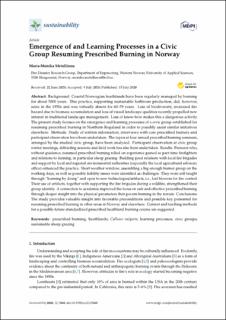| dc.contributor.author | Log, Maria-Monika Metallinou | |
| dc.coverage.spatial | Norway | en_US |
| dc.date.accessioned | 2020-12-07T08:49:42Z | |
| dc.date.available | 2020-12-07T08:49:42Z | |
| dc.date.created | 2020-07-16T20:17:27Z | |
| dc.date.issued | 2020 | |
| dc.identifier.citation | Metallinou, M.-M. (2020). Emergence of and learning processes in a civic group resuming prescribed burning in norway. Sustainability, 12(14). | en_US |
| dc.identifier.issn | 2071-1050 | |
| dc.identifier.uri | https://hdl.handle.net/11250/2712091 | |
| dc.description.abstract | Background: Coastal Norwegian heathlands have been regularly managed by burning for about 5000 years. This practice, supporting sustainable herbivore production, did, however, seize in the 1950s and was virtually absent for 60–70 years. Loss of biodiversity, increased fire hazard due to biomass accumulation and loss of visual landscape qualities recently propelled new interest in traditional landscape management. Loss of know-how makes this a dangerous activity. The present study focuses on the emergence and learning processes of a civic group established for resuming prescribed burning in Northern Rogaland in order to possibly assist similar initiatives elsewhere. Methods: Study of written information, interviews with core prescribed burners and participant observation have been undertaken. The topics at four annual prescribed burning seminars, arranged by the studied civic group, have been analyzed. Participant observation at civic group winter meetings, debriefing sessions and field work has also been undertaken. Results: Pioneers who, without guidance, resumed prescribed burning relied on experience gained as part-time firefighters and relations to farming, in particular sheep grazing. Building good relations with local fire brigades and support by local and regional environmental authorities (especially the local agricultural advisory office) enhanced the practice. Short weather window, assembling a big enough burner group on the working days, as well as possible liability issues were identified as challenges. They were self-taught through “learning by doing” and open to new technologies/artifacts, i.e., leaf blowers for fire control. Their use of artifacts, together with supporting the fire brigades during a wildfire, strengthened their group identity. A connection to academia improved the focus on safe and effective prescribed burning through deeper insight into the physical parameters that govern burning in the terrain. Conclusions: The study provides valuable insight into favorable preconditions and possible key personnel for resuming prescribed burning in other areas in Norway and elsewhere. Content and teaching methods for a possible future standardized prescribed heathland burning course are suggested. | en_US |
| dc.language.iso | eng | en_US |
| dc.publisher | MDPI | en_US |
| dc.rights | Navngivelse 4.0 Internasjonal | * |
| dc.rights.uri | http://creativecommons.org/licenses/by/4.0/deed.no | * |
| dc.subject | prescribed burning | en_US |
| dc.subject | heathlands | en_US |
| dc.subject | Calluna vulgaris | en_US |
| dc.subject | learning processes | en_US |
| dc.subject | civic groups | en_US |
| dc.subject | sustainable sheep grazing | en_US |
| dc.title | Emergence of and learning processes in a civic group resuming prescribed burning in Norway | en_US |
| dc.type | Peer reviewed | en_US |
| dc.type | Journal article | en_US |
| dc.description.version | publishedVersion | en_US |
| dc.rights.holder | © 2020 by the author | en_US |
| dc.source.pagenumber | 21 | en_US |
| dc.source.volume | 12 | en_US |
| dc.source.journal | Sustainability | en_US |
| dc.source.issue | 14 | en_US |
| dc.identifier.doi | 10.3390/su12145668 | |
| dc.identifier.cristin | 1819643 | |
| dc.relation.project | Norges forskningsråd: 298993 | en_US |
| cristin.ispublished | true | |
| cristin.fulltext | original | |
| cristin.qualitycode | 1 | |

